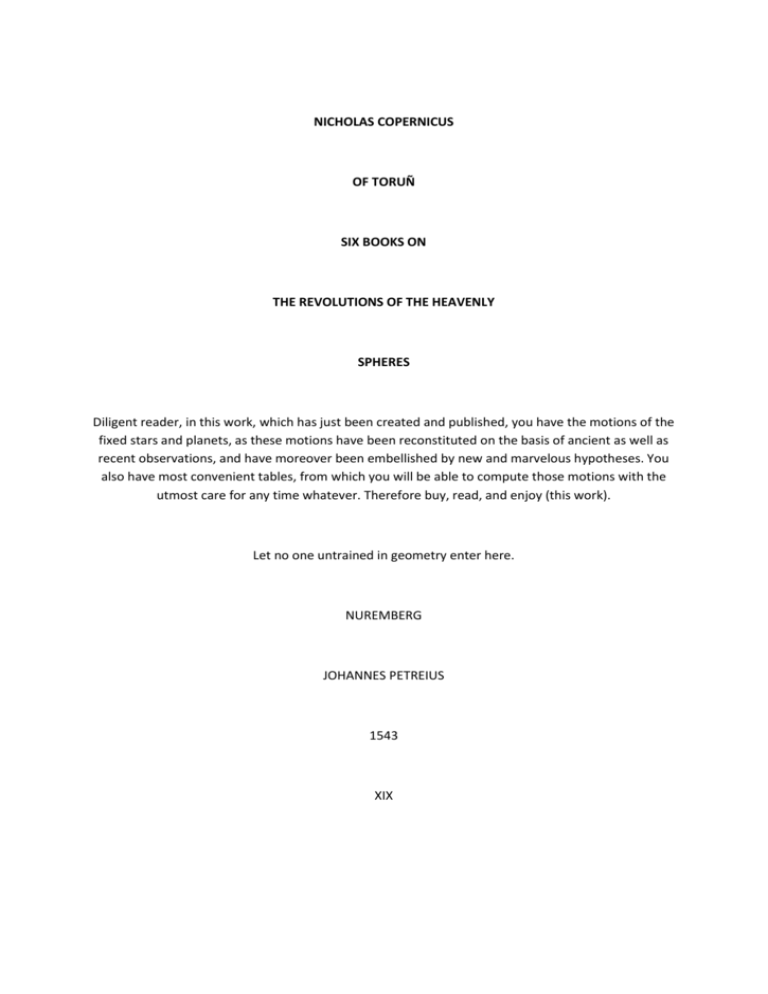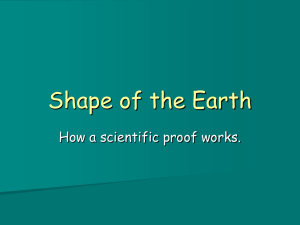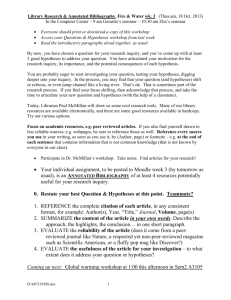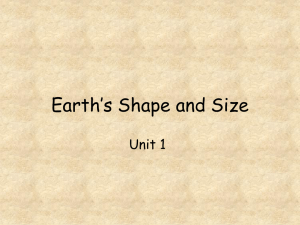NICHOLAS COPERNICUS OF TORUŃ SIX BOOKS ON THE
advertisement

NICHOLAS COPERNICUS OF TORUÑ SIX BOOKS ON THE REVOLUTIONS OF THE HEAVENLY SPHERES Diligent reader, in this work, which has just been created and published, you have the motions of the fixed stars and planets, as these motions have been reconstituted on the basis of ancient as well as recent observations, and have moreover been embellished by new and marvelous hypotheses. You also have most convenient tables, from which you will be able to compute those motions with the utmost care for any time whatever. Therefore buy, read, and enjoy (this work). Let no one untrained in geometry enter here. NUREMBERG JOHANNES PETREIUS 1543 XIX FOREWORD BY ANDREAS OSIANDER To the Reader Concerning the Hypotheses of this Work There have already been widespread reports about the novel hypotheses of this work, which declares that the earth moves whereas the sun is at rest in the center of the universe. Hence certain scholars, I have no doubt, are deeply offended and believe that the liberal arts, which were established long ago on a sound basis, should not be thrown into confusion. But if these men are willing to examine the matter closely, they will find that the author of this work has done nothing blameworthy. For it is the duty of an astronomer to compose the history of the celestial motions through careful and expert study. Then he must conceive and devise the causes of these motions or hypotheses about them. Since he cannot in any way attain to the true causes, he will adopt whatever suppositions enable the motions to be computed correctly from the principles of geometry for the future as well as for the past. The present author has performed both these duties excellently. For these hypotheses need not be true nor even probable. On the contrary, if they provide a calculus consistent with the observations, that alone is enough. Perhaps there is someone who is so ignorant of geometry and optics that he regards the epicycle of Venus as probable, or thinks that it is the reason why Venus sometimes precedes and sometimes follows the sun by forty degrees and even more. Is there anyone who is not aware that from this assumption it necessarily follows that the diameter of the planet at perigee should appear more than four times, and the body of the planet more than sixteen times, as great as at apogee? Yet this variation is refuted by the experience of every age. In this science there are some other no less important absurdities, which need not be set forth at the moment. For this art, it is quite clear, is completely and absolutely ignorant of the causes of the apparent nonuniform motions. And if any causes are devised by the imagination, as indeed very many are, they are not put forward to convince anyone that are true, but merely to provide a reliable basis for computation. However, since different hypotheses are sometimes offered for one and the same motion (for example, eccentricity and an epicycle for the sun’s motion), the astronomer will take as his first choice that hypothesis which is the easiest to grasp. The philosopher will perhaps rather seek the semblance of the truth. But neither of them will understand or state anything certain, unless it has been divinely revealed to him. Therefore alongside the ancient hypotheses, which are no more probable, let us permit these new hypotheses also to become known, especially since they are admirable as well as simple and bring with them a huge treasure of very skillful observations. So far as hypotheses are concerned, let no one expect anything certain from astronomy, which cannot furnish it, lest he accept as the truth ideas conceived for another purpose, and depart from this study a greater fool than when he entered it. Farewell. XX .................................................................. Chapter 1 THE UNIVERSE IS SPHERICAL First of all, we must note that the universe is spherical. The reason is either that, of all forms, the sphere is the most perfect, needing no joint and being a complete whole, which can be neither increased nor diminished; or that it is the most capacious of figures, best suited to enclose and retain all things; or even that all the separate parts of the universe, I mean the sun, moon, planets and stars, are seen to be of this shape; or that wholes strive to be circumscribed by this boundary, as is apparent in drops of water and other fluid bodies when they seek to be self-contained. Hence no one will question the attribution of this form to the divine bodies. Chapter 2 THE EARTH TOO IS SPHERICAL The earth also is spherical, since it presses upon its center from every direction. Yet it is not immediately recognized as a perfect sphere on account of the great height of the mountains and depth of the valleys. They scarcely alter the general sphericity of the earth, however, as is clear from the following considerations. For a traveler going from any place toward the north, that pole of the daily rotation gradually climbs higher, while the opposite pole drops down an equal amount. More stars in the north are seen not to set, while in the south certain stars are no longer seen to rise. Thus Italy does not see Canopus, which is visible in Egypt; and Italy does see the River’s last star, which is unfamiliar to our area in the colder region. Such stars, conversely, move higher in the heavens for a traveler heading southward, while those which are high in our sky sink down. Meanwhile, moreover, the elevations of the poles have the same ratio everywhere to the portions of the earth that have been traversed. This happens on no other figure than the sphere. Hence the earth too is evidently enclosed between poles and is therefore spherical. Furthermore, evening eclipses of the sun and moon are not seen by easterners, nor morning eclipses by westerners, while those occurring in between are seen later by easterners but earlier by westerners. The waters press down into the same figure also, as sailors are aware, since land which is not seen from a ship is visible from the top of its mast. On the other hand, if a light is attached to the top of the mast, as the ship draws away from land, those who remain ashore see the light drop down gradually until it finally disappears, as though setting. Water, furthermore, being fluid by nature, manifestly always seeks the same lower levels as earth and pushes up from the shore no higher than its rise permits. Hence whatever land emerges out of the ocean is admittedly that much higher. ......................................................... Chapter 11 PROOF OF THE EARTH’S TRIPLE MOTION In so many and such important ways, then, do the planets bear witness to the earth’s mobility. I shall now give a summary of this motion, insofar as the phenomena are explained by it as a principle. As a whole, it must be admitted to be a threefold motion. The first motion, named nuchthemeron by the Greeks, as I said (I, 4), is the rotation which is the characteristic of a day plus a night. This turns around the earth’s aids from west to east, just as the universe is deemed to be carried in the opposite direction. It describes the equator, which some people call the "circle of equal days", in imitation of the designation used by the Greeks, whose term for it is isemerinos. The second is the yearly motion of the center, which traces the ecliptic around the sun. Its direction is likewise from west to east, that is, in the order of the zodiacal signs. It travels between Venus and Mars, as I mentioned (I, 10), together with its associates. Because of it, the sun seems to move through the zodiac in a similar motion. Thus, for example, when the earth’s center is passing through the Goat, the sun appears to be traversing the Crab; with the earth in the Water Bearer, the sun seems to be in the Lion, and so on, as I remarked. To this circle, which goes through the middle of the signs, and to its plane, the equator and the earth’s axis must be understood to have a variable inclination. For if they stayed at a constant angle, and were affected exclusively by the motion of the center, no inequality of days and nights would be observed. On the contrary, it would always be either the longest or shortest day or the day of equal daylight and darkness, or summer or winter, or whatever the character of the season, it would remain identical and unchanged. The third motion in inclination is consequently required. This also is a yearly revolution, but it occurs in the reverse order of the signs, that is, in the direction opposite to that of the motion of the center. These two motions are opposite in direction and nearly equal in period. The result is that the earth’s axis and equator, the largest of the parallels of latitude on it, face almost the same portion of the heavens, just as if they remained motionless. Meanwhile the sun seems to move through the obliquity of the ecliptic with the motion of the earth’s center, as though this were the center of the universe. Only remember that, in relation to the sphere of the fixed stars, the distance between the sun and the earth vanishes from our sight forthwith. Since these are matters which crave to be set before our eyes rather than spoken of, let us describe a circle ABCD, which the annual revolution of the earth’s center has traced in the plane of the ecliptic. Near its center let the sun be E. I shall divide this circle into four parts by drawing the diameters AEC and BED. Let A represent the first point of the Crab, B of the Balance, C of the Goat, and D of the Ram. Now let us assume that the earth’s center is originally at A. About A I shall draw the terrestrial equator FGHI. This is not in the same plane (as the ecliptic), except that the diameter GAI is the intersection of the circles, I mean, of the equator and the ecliptic. Draw also the diameter FAH perpendicular to GAI, F being the limit of the (equator’s) greatest inclination to the south, and H to the north. Under the conditions thus set forth, the earth’s inhabitants will see the sun near the center E undergo the winter solstice in the Goat. This occurs because the greatest northward inclination, H, is turned toward the sun. For, the inclination of the equator to the line AE, through the agency of the daily rotation, traces the winter solstice parallel to the equator at an interval subtended by EAH, the angle of the obliquity. .............................................................................






